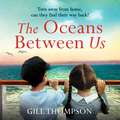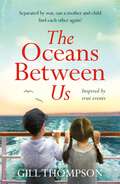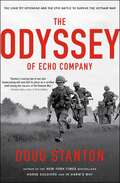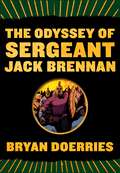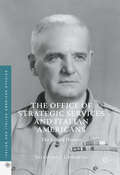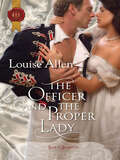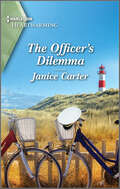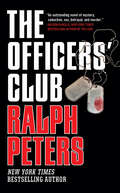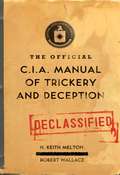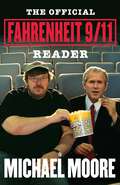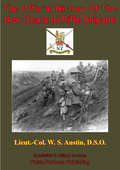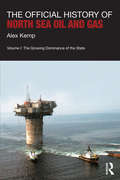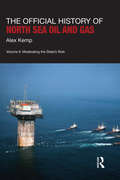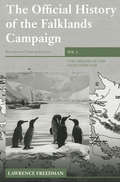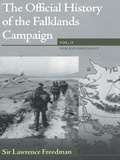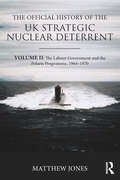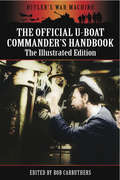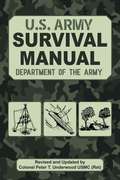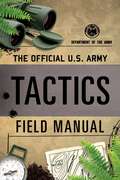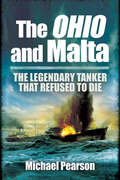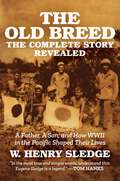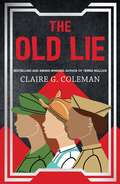- Table View
- List View
The Oceans Between Us: A gripping and heartwrenching novel of a mother's search for her lost child after WW2
by Gill ThompsonInspired by extraordinary true events, this remarkable debut novel reveals the enduring power of love and the strength of the human spirit in one woman's quest to find her son, and a little boy's dream to be found. For readers of The Letter by Kathryn Hughes, Before We Were Yours by Lisa Wingate, The Throwaway Children by Diney Costeloe, Lilac Girls by Martha Hall Kelly and Remember Me by Lesley Pearse.Molly. Found wandering injured and dazed after an air raid on London, she remembers nothing of who she is. Except that she has lost something very precious...Jack. His mother disappeared in the bombing. As he waits in the orphanage he knows one day she'll return for him. But when the opportunity of a golden life is dangled before him, and it's clear his mother's gone, aged nine he boards the SS Asturias, bound for Fremantle, the Outback - and Bindoon Boys' Town.Kathleen Sullivan. Trapped in a repressive marriage. When the young English boy, undernourished and wary after the brutalities of the Christian Brothers' Outback farm, comes to live with her and her civil servant husband in Perth, she sees in Jack the son she was never able to have. But are they both too damaged to piece together a family?A powerful, moving story of broken families and mended lives, told with care and compassion, The Oceans Between Us is a riveting, heartwrenching and ultimately uplifting novel of a mother's fight for justice and a boy's fight for survival.
The Oceans Between Us: A gripping and heartwrenching novel of a mother's search for her lost child after WW2
by Gill ThompsonInspired by heartrending true events, a mother fights to find her son and a child battles for survival in this riveting debut novel. 'A warm-hearted tale of love, loss and indefatigable human spirit' Kathryn Hughes 'A heartrending story' Jane Corry 'A mother's loss and a son's courage... A heartrending story that spans the world' Diney CosteloeFor readers of Before We Were Yours by Lisa Wingate, Lilac Girls by Martha Hall Kelly, The Letter by Kathryn Hughes, and Remember Me by Lesley Pearse.A woman is found wandering injured in London after an air raid. She remembers nothing of who she is. Only that she has lost something very precious.As the little boy waits in the orphanage, he hopes his mother will return. But then he finds himself on board a ship bound for Australia, the promise of a golden life ahead, and wonders: how will she find him in a land across the oceans?In Perth, a lonely wife takes in the orphaned child. But then she discovers the secret of his past. Should she keep quiet? Or tell the truth and risk losing the boy who has become her life? This magnificent, moving novel, set in London and Australia, is testament to the strength of the human spirit and the enduring power of love.Readers worldwide have fallen in love with The Oceans Between Us...'A beautiful tale of a mother's love. A wonderful book. Full of emotion, heart, joy and sorrow' Emma's Bookish Corner'Heart-wrenching debut novel. A story based on actual events which will have you glued to the pages' Waggy Tales'It has opened my eyes to the injustice done to so many' Shaz's Book Blog'I flew through this emotional book. I raged at just what some had to endure. But I also felt their bravery in finding justice for all children who suffered. Highly recommended' Between My Lines'A story that will touch every reader's heart. An absolute must-read' By The Letter Book Reviews
The Oceans Between Us: A gripping and heartwrenching novel of a mother's search for her lost child after WW2
by Gill ThompsonInspired by heartrending true events, a mother fights to find her son and a child battles for survival in this riveting debut novel. 'A warm-hearted tale of love, loss and indefatigable human spirit' Kathryn Hughes 'A heartrending story' Jane Corry 'A mother's loss and a son's courage... A heartrending story that spans the world' Diney CosteloeFor readers of Before We Were Yours by Lisa Wingate, Lilac Girls by Martha Hall Kelly, The Letter by Kathryn Hughes, and Remember Me by Lesley Pearse.A woman is found wandering injured in London after an air raid. She remembers nothing of who she is. Only that she has lost something very precious.As the little boy waits in the orphanage, he hopes his mother will return. But then he finds himself on board a ship bound for Australia, the promise of a golden life ahead, and wonders: how will she find him in a land across the oceans?In Perth, a lonely wife takes in the orphaned child. But then she discovers the secret of his past. Should she keep quiet? Or tell the truth and risk losing the boy who has become her life? This magnificent, moving novel, set in London and Australia, is testament to the strength of the human spirit and the enduring power of love.Readers worldwide have fallen in love with The Oceans Between Us...'A beautiful tale of a mother's love. A wonderful book. Full of emotion, heart, joy and sorrow' Emma's Bookish Corner'Heart-wrenching debut novel. A story based on actual events which will have you glued to the pages' Waggy Tales'It has opened my eyes to the injustice done to so many' Shaz's Book Blog'I flew through this emotional book. I raged at just what some had to endure. But I also felt their bravery in finding justice for all children who suffered. Highly recommended' Between My Lines'A story that will touch every reader's heart. An absolute must-read' By The Letter Book Reviews** DON'T MISS THE ORPHANS ON THE TRAIN, COMING SOON FROM GILL THOMPSON **
The Odyssey of Echo Company: The 1968 Tet Offensive and the Epic Battle to Survive the Vietnam War
by Doug StantonA powerful work of literary military history from the New York Times bestselling author of In Harm’s Way and Horse Soldiers, the harrowing, redemptive, and utterly unforgettable account of an American army reconnaissance platoon’s fight for survival during the Vietnam War—whose searing experiences reverberate today among the millions of American families touched by this war.On a single night, January 31, 1968, as many as 100,000 soldiers in the North Vietnamese Army attacked thirty-six cities throughout South Vietnam, hoping to topple the government and dislodge American forces. Forty young American soldiers of an army reconnaissance platoon (Echo Company, 1/501) of the 101st Airborne Division and hailing from small farms, beach towns, and such big cities as Chicago and Los Angeles are suddenly thrust into savage combat, having been in-country only a few weeks. Their battles against both North Vietnamese Army soldiers and toughened Viet Cong guerillas are relentless, often hand-to-hand, and waged night and day across landing zones, rice paddies, hamlets, and dense jungle. The exhausting day-to-day existence, which involves ambushes on both sides, grueling gun battles, and heroic rescues of wounded comrades, forges the group into a lifelong brotherhood. The Odyssey of Echo Company is about the young men who survived this epic span, and centers on the searing experiences of one of them, Stanley Parker, who is wounded three times during the fighting. When the young men come home, some encounter a country that doesn’t understand what they have suffered and survived. Many of them fall silent, knowing that few of their countrymen want to hear the remarkable story they have lived to tell—until now. Based on hundreds of hours of interviews, dozens of personal letters written in the combat zone, Pentagon after-action reports, and travel to the battle sites with some of the soldiers (who meet their Vietnamese counterpart), and augmented by detailed maps and remarkable combat zone photographs, The Odyssey of Echo Company breaks through the wall of time to recount ordinary young American men in an extraordinary time in America and confirms Doug Stanton’s prominence as an unparalleled storyteller of our age.
The Odyssey of Sergeant Jack Brennan (Pantheon Graphic Library)
by Bryan DoerriesA bold and original graphic novelization of The Odyssey that is both a powerful story for our time—capturing its timeless lessons for returning veterans of Afghanistan and Iraq—as well as a vivid new way into Homer's classic for modern readers.Jack Brennan is a Marine Corps sergeant whose infantry squad has been cleared to return home from a grueling deployment to Afghanistan. A few years prior, Sergeant Brennan lost one of his closest friends—a young combat veteran—to suicide and has vowed to do everything in his power to keep his Marines from a similar fate. On their last night in-country, Brennan shares his version of The Odyssey to help prepare his squad for the transition back to the home front. By retelling Homer's epic about Odysseus' difficult journey home after the Trojan War, and weaving in the stories of contemporary Marines, The Odyssey of Sergeant Jack Brennan powerfully conveys the profound challenges today's veterans face upon returning from combat even as it tells "the oldest war story of all time."
The Office of Strategic Services and Italian Americans
by Salvatore J. LaguminaThis book explores the contributions of Italian Americans employed by the Office of Strategic Services (OSS) during World War II. Italian Americans fluent in Italian language and customs became integral parts of intelligence operations working behind enemy lines. These units obtained priceless military information that significantly helped defeat the Axis. They parachuted into frozen mountains tops to link up with Italian guerilla units in northern Italy or hovered in small patrol torpedo boats and row boats across the Mediterranean Sea in pitch black darkness to destroy railroad junctions.
The Officer and the Proper Lady
by Louise AllenA proper English lady battles her desire for a rakish officer as Napoleon marches into Brussels in this sexy Regency romance.Major Hal Carlow was a fine soldier, but he was also a flirt, a rake and a scoundrel! In general, he tried to steer clear of proper young ladies—no fun at all—and spend time with the sort of women who appreciated his finer qualities. . . .Miss Julia Tresilian’s duty was to find a husband, but her prospective suitors bored her to tears. Yet even talking to the incorrigible Hal Carlow was dangerous to her marriage prospects, let alone anything more. . . .
The Officer's Dilemma: A Clean and Uplifting Romance
by Janice CarterAn impossible choice…Or a new adventure together?Zanna Winters has five months to plan the rest of her life—including the impossible choice of whether to leave Lighthouse Cove and her family&’s hotel behind. Unfortunately, Naval Officer Dominic Kennedy&’s return to their small town is complicating that plan. Because now Zanna must tell Dominic the truth: they&’re having a baby. Neither planned for a life in Lighthouse Cove…but is love enough to bring two wandering hearts home for good?From Harlequin Heartwarming: Wholesome stories of love, compassion and belonging.
The Officers' Club
by Ralph PetersSpring, 1981. Vietnam is over, but the repercussions linger. The military strives to recover as society reels from the excesses of the 1970s…A sinister beauty and a dutiful soldier… a Hollywood lawyer running from a dirty past and a cast-off vet who seems to have no future… dueling drug gangs along the Mexican border… and the mutilated remains of a female lieutenant. Stunning, promiscuous, and brilliant at spotting the weaknesses in others, Jessie Lamoureaux may have been killed by a jealous lover, a drug smuggler—or a ghost from a life she hoped she had left behind. Was her murderer the Green Beret she betrayed? The captain whose marriage she shattered? The senior officer hoping to save her from herself? A female sergeant fighting for dignity in a man's world? Or a fellow lieutenant with a secret of his own?In this gritty tale of young men and women torn between the laws of the land and the laws of the heart, a dark journey leads from a moonlit beach in Mexico to mayhem in Iran—then back to a country looking for its soul.The Officers' Club captures the passions and confusion of the times, the reckoning due after a decade of indulgence—and the commitment of those who stayed in uniform through the bad years.As the military and society struggle to right themselves, their conflicts are embodied in the question: Who killed Lieutenant Jessie Lamoureux? At the Publisher's request, this title is being sold without Digital Rights Management Software (DRM) applied.
The Officers' Wives
by Thomas J. FlemingThis is a book [novel] you will never forget. It is about the U.S. Army, the huge unwieldly organism on which much of the nation's survival depends. It is about Americans trying to live personal lives, to cling to touchstones of faith and hope in the grip of the blind, blunderous history of the last 25 years. It is about marriage, the illusions and hopes that people bring to it, the struggle to maintain and renew commitment. On June 5, 1950, graduation day at West Point, Joanna Welsh of Cincinnati, poet and idealist, walks beneath an arch of shining sabers, the bride of Peter MacArthur Burke, one of the stars of Army's perenially victorious football team. Within minutes she is followed by Amy Kemble, the cool, tough-minded Philadelphia heiress, who has married George Rosser, a somewhat bland but clever Californian. Next comes red-haired Honor Prescott of Charlesville, Virginia, giddily in love with Adam Thayer of Maine, who hides his brilliance-and his reckless idealism-behind a stream of jokes and comic impersonations. Even as the new second lieutenants and their wives drank champagne, tanks and artillery were being posi-( ^ tioned on an obscure Asian peninsula named Korea. War explodes before their honeymoons are over-and history becomes a dark presence in their lives. For Joanna it is the beginning of a spiritual journey that strips away her simplistic Catholic faith and teaches her harsh lessons about life's brutality, love's limitations. For Amy, war- whether in Korea or Vietnam-merely complicates her efforts to make George a general-until she discovers that courage is at the heart of the kind of love she needs and wants. Honor must grapple with a marriage that often teeters on oblivion, as Adam's experience in the Army-above all his opposition to the war in Vietnam-turns him into a savage cynic. Ranging from occupied Germany and Japan of the 1950s to the steamy chaos of Saigon and Bangkok in the 1960s, the officers' wives is a global drama told by a writer whose gifts as a novelist and historian here achieve a triumphant fusion. A sense of history, an awareness of the impact of the past on every level of life from the experience of the individual to the travails of a city to the crises of the nation, makes Thomas Fleming's fiction and nonfiction consistently interesting and important.
The Official CIA Manual of Trickery and Deception
by Robert Wallace H. Keith MeltonMagic or spycraft? In 1953, against the backdrop of the Cold War, the CIA initiated a top-secret program, code-named MKULTRA, to counter Soviet mind-control and interrogation techniques. Realizing that clandestine officers might need to covertly deploy newly developed pills, potions, and powders against the adversary, the CIA hired America's most famous magician, John Mulholland, to write two manuals on sleight of hand and undercover communication techniques. In 1973, virtually all documents related to MKULTRA were destroyed. Mulholland's manuals were thought to be among them--until a single surviving copy of each, complete with illustrations, was recently discovered in the agency's archives. The manuals reprinted in this work represent the only known complete copy of Mulholland's instructions for CIA officers on the magician's art of deception and secret communications.
The Official Fahrenheit 9/11 Reader
by Michael MooreFrom the Oscar and Emmy-winning director of Fahrenheit 9/11 comes the official guide to the film, including the complete screenplay of the 2004 Cannes Film Festival Best Picture Award winner. The Cannes Film Festival jury voted unanimously to award the 2004 Best Picture Award to Michael Moore and Fahrenheit 9/11. Since then, it has gone on to smash all box office records for a documentary and created an international discussion about the Bush administration and the war in Iraq. The Official Fahrenheit 9/11 Reader is a powerful and informative book that includes the complete screenplay of the most provocative film of the year. The book also includes extensive sources that back up all facts in the film, as well as articles, letters, photos, and cartoons about the most influential documentary of all time.
The Official History Of The New Zealand Rifle Brigade [Illustrated Edition]
by Captain William Esmonde Lennox NapierOver 40 Illustrations of the officers, men and battles they engaged in.The Rifle Brigade has a long and distinguished history in the British Army as a corps of elite troops with a fighting pedigree stretching back to the times of Wellington, the Peninsular War and Waterloo. During the First World War the huge number of volunteers from New Zealand overstripped the ability of the administration to provide more than one brigade of infantry in 1915. However in 1916 a second brigade was formed and was designated as the New Zealand Rifle Brigade, marrying the traditions of the British Rifle Brigade for the highest standards of soldiery and the New Zealand traditions of courage, native skill and toughness.The New Zealand Rifle Brigade fought with distinction across the British zones of the battlefields of France and Flanders. As their official historian recounts with his vivid narrative from the bloody but successful debut at the battle of Flers-Courcelette, the battle of Messines, Passchendaele and the dark days of the German offensives in 1918, the "Dinks" as they were known covered themselves in glory. They would produce two Victoria cross winners from their ranks and many of their men would return to their native islands with other high honours for gallantry and bravery. However, the losses of these brave men were prodigious and the names of the fallen are inscribed in full detail in an appendix at the end of the book.
The Official History of North Sea Oil and Gas: Vol. I: The Growing Dominance of the State (Government Official History Series)
by Alex KempWritten by the leading expert in UK petroleum economics, this study provides a new, unique, in-depth analysis of the development of British policies towards the North Sea oil and gas industry from the early 1960s to the early 1980s. Drawing on full access to the UK Government’s relevant archives, Alex Kemp examines the thinking behind the initial legislation in 1964, the early licensing arrangements and the events leading up to the boundary delimitation agreements with Norway and other adjacent North Sea countries. He explains the debate in the later 1960s about the appropriate role of the state in the exploitation of the gas and oil resources, the prolonged negotiations resulting in the early long-term gas contracts, and the continuing debate on the role of the state following the large oil discoveries in the first half of the 1970s resulting in the formation of BNOC (British National Oil Corporation). The debate leading up to the introduction of, and subsequent increase in, the Petroleum Revenue Tax is fully explained as is the introduction of Supplementary Petroleum Duty. The author also outlines the debates around interventionist depletion policies and on how the oil revenues should best be utilised. The Official History of North Sea Oil and Gas will be of much interest to students of North Sea oil and gas, energy economics, business history, and British politics, as well as to petroleum professionals and policymakers.
The Official History of North Sea Oil and Gas: Vol. II: Moderating the State’s Role (Government Official History Series)
by Alex KempWritten by the leading expert in the history of UK energy, this study provides new, in-depth analysis of the development of UK petroleum policies towards the North Sea oil and gas industry from the early 1960s to the early 1980s. Following on from volume I (The Growing Dominance of the State) to discuss the more recent history of the North Sea oil and gas industry, here Alex Kemp offers new insights into developments in the industry. The controversial decisions to raise gas prices to consumers and to introduce the Gas Levy are discussed, while the thinking behind the gradual reduction in taxation - including the abolition of SPD (Supplementary Petroleum Duty) and the removal of royalties on new developments - is fully explained. The various options considered to reduce the powers of BNOC (British National Oil Corporation), then privatise its upstream assets, and finally to abolish the state company altogether are fully discussed, as is the thinking leading up to the privatisation of the British Gas Corporation in 1986. This volume also sheds light on the development of policies onshore, particularly the role of the OSO (Offshore Supplies Office), and the response of British industry to the North Sea opportunity. Finally, the evolution of policies relating to health, safety, decommissioning, and the environment over the whole period of the study are examined. The Official History of North Sea Oil and Gas will be of interest to students of North Sea oil and gas, energy economics, business history, and British politics, as well as to petroleum professionals and policymakers.
The Official History of the Falklands Campaign, Volume 1: The Origins of the Falklands War (Government Official History Series)
by Lawrence FreedmanDrawing on a vast range of previously classified government archives as well as interviews with key participants, this first volume of the official history of the Falklands Campaign is the most authoritative account of the origins of the 1982 war. In the first chapters the author analyzes the long history of the dispute between Argentina and Britain over the sovereignty of the Islands, the difficulties faced by successive governments in finding a way to reconcile the opposed interests of the Argentines and the islanders, and the constant struggle to keep the Islands viable. He subsequently gives a complete account of how what started as an apparently trivial incident over an illegal landing by scrap-metal merchants on the island of South Georgia turned into a major crisis. Thanks to his access to classified material, Lawrence Freedman has been able to produce a detailed and authoritative analysis which extends the coverage given by the Franks Committee Report of 1983. This volume is ultimately an extremely readable account of these events, charting the growing realization within the British government of the seriousness of the situation, culminating in the Argentine invasion of the Falkland Islands at the start of April 1982.
The Official History of the Falklands Campaign, Volume 2: War and Diplomacy (Government Official History Series)
by Lawrence FreedmanIn this official history of the Falklands Campaign, Lawrence Freedman provides a detailed and authoritative account of one of the most extraordinary periods in recent British political history and a vivid portrayal of a government at war. After the shock of the Argentine invasion of the Falklands in April 1982, Margaret Thatcher faced the crisis that came to define her premiership as she determined to recover the islands. Freedman covers all aspects of the campaign - economic and diplomatic as well as military - and demonstrates the extent of the gamble that the government took. There are important accounts of the tensions in relations with the United States, concerns among the military commanders about the risks they were expected to take, the problems of dealing with the media and the attempts to reach a negotiated settlement. This definitive account describes in dramatic detail events such as the sinking of the Belgrano, the battle of Goose Green and the final push to Stanley. Special attention is also paid to the aftermath of the war, including the various enquiries, and the eventual restoration of diplomatic relations with Argentina.
The Official History of the UK Strategic Nuclear Deterrent: Volume II: The Labour Government and the Polaris Programme, 1964-1970 (Government Official History Series)
by Matthew JonesVolume II of The Official History of the UK Strategic Nuclear Deterrent provides an authoritative and in-depth examination of the British government’s strategic nuclear policy from 1964 to 1970. Written with full access to the UK documentary record, Volume II examines the controversies that developed over nuclear policy following the arrival in office of a Labour government led by Harold Wilson in October 1964 that openly questioned the independence of the deterrent. Having decided to preserve the Polaris programme, Labour ministers were nevertheless committed not to develop another generation of nuclear weapons beyond those in the pipeline, placing major doubts over the long-term future of the nuclear programme and collaboration with the United States. Defence planners also became increasingly concerned that the deployment of Soviet anti-ballistic missile (ABM) defences around Moscow threatened to undermine the ability of Polaris to fulfil its role as a national strategic nuclear deterrent. During 1967, under heavy pressures to control defence spending, a protracted debate was conducted within Whitehall over the future of Polaris and how to respond to the evolving ABM challenge. The volume concludes with Labour’s defeat at the general election of June 1970, by which time the Royal Navy had assumed the nuclear deterrent role from the RAF, and plans had already been formulated for a UK project to improve Polaris which could both ensure its continuing credibility and rejuvenate the Anglo-American nuclear relationship. This book will be of much interest to students of British politics, Cold War history, nuclear proliferation and international relations.
The Official U-Boat Commanders Handbook: The Illustrated Edition (Hitler's War Machine)
by Bob CarruthersThis is the complete wartime translation by the U.S. Navy of the 1943 edition of the official handbook given to all U-boat commanders. The original handbook was compiled from combat reports and was regularly updated throughout the war. The handbook was an invaluable reference for every operational U-boat commander. Simply written and highly accessible for a wider audience, the U-boat handbook attempted to anticipate every possible situation and to advise on suitable tactics. This superb war-time primary source is enhanced by a rare series of photographs taken on an actual combat patrol and published during the time of the Third Reich in the book U-Boot Auf Feindfahrt.Together the handbook and these rare photographs provide a fascinating glimpse into the world of the U-boats from a first hand perspective, and is essential reading for anyone interested in World War II from primary sources.
The Official U.S. Army Survival Manual Updated (US Army Survival)
by Peter T. Underwood Department of the ArmyThis comprehensive new edition of U.S. Army Survival Manual, issued by the Department of the Army and thoroughly revised by Colonel Peter T. Underwood USMC (Ret), is ideal for military personnel and all outdoors enthusiasts. From the psychology of survival and basic medicine to personal camouflage and signaling techniques, this essential resource provides all the information you need to survive. Included here is a guide to identifying: • Poisonous snakes and lizards • Edible plants • Cloud formations as foretellers of weather • And more! With detailed photographs and illustrations and an extensive set of appendices, U.S. Army Survival Manual is your ultimate guide to survival in all conditions and environs.
The Official U.S. Army Tactics Field Manual
by Department of the ArmyTactics is the art and science of employing all available means to win battles and engagements. Specifically, it comprises the actions taken by a commander to arrange units and activities in relation to each other and the enemy. Filled with diagrams of attack plans, defensive strategies, and troop movements, U.S. Army Tactics Field Manual is the playbook the U.S. Army uses to employ available means to win in combat. This book provides combat-tested concepts and ideas modified to exploit emerging Army and joint capabilities. This book focuses on the organization of forces, minimum essential control measures, and general planning, preparation, and execution considerations for each type and form of combat operation. It is the common reference for all students of the tactical art, both in the field and the Army school system. The Art of Tactics * Common Tactical Concepts and Graphic Control Measures * The Basics of Offense * Movement to Contact * Attack * Exploitation * Pursuit * Basics of Defensive Operations * The Area of Defense * The Mobile Defense * The Retrograde * Security Operations * Reconnaissance Operations * Troop Movement * Relief in Place * Passage of Lines.
The Ohio and Malta: The Legendary Tanker That Refused to Die
by Michael PearsonDuring the dark days of World War 2, Malta became the lynchpin of the Allied campaign in the Mediterranean and North African theaters and a vital base from which to attack Axis convoys supplying Rommel's Panzer Armee in Libya. Malta was, however, extremely difficult to keep supplied, (particularly with oil), and by the summer of 1942 the Island was close to surrender; the Pedestal convoy of August that year was literally the last chance.On entering the Mediterranean, the convoy was subjected to prolonged ferocious air and submarine attacks and suffered terrific losses both in warship escorts and merchant men. OHIO, being the only tanker, was marked for particular attention, and during the course of her voyage suffered a direct hit from a torpedo, direct bomb hits, any number of near-misses, and was struck by two Luftwaffe aircraft shot down while attacking her. Despite her engines being dead and her hull practically broken in two, she was towed into Grand Harbor by three destroyers and a minesweeper with her vital cargo virtually intact.
The Old Breed... The Complete Story Revealed: A Father, A Son, and How WWII in the Pacific Shaped Their Lives
by W. Henry SledgeForty years after the publication of Eugene Sledge&’s memoir With the Old Breed at Peleliu and Okinawa comes The Old Breed… The Complete Story Revealed by Eugene&’s son, Henry, adding new material and immeasurable depth to his father&’s story.The Old Breed… The Complete Story Revealed brings to life an abundance of new material from the original manuscript of Eugene Sledge&’s classic memoir With the Old Breed at Peleliu and Okinawa. By interspersing his own personal anecdotes throughout, Henry Sledge takes his father&’s work and gives it newfound context, sharing memories of conversations between father and son. The result is a flowing narrative that portrays an intimate look at a WWII veteran and his struggles to adapt to civilian life following the war.
The Old Contemptibles (Routledge Library Editions: Military and Naval History)
by Keith SimpsonThis book, originally published in 1981, tells the story of the regular soldiers and reservists of the British Expeditionary Force (B. E. F.) who fought in the first six months of the First World War on the Western Front. This photographic history of the B. E. F. is unique in that the photographs were taken not by official war photographers, but either by the few press photographers who were able to get near the Front or by members of the B. E. F themselves. Complementing the photographs are many first-hand accounts of their experiences by ‘Old Contemptibles’ and an authoritative text by Keith Simpson.
The Old Lie
by Claire G. ColemanShane Daniels and Romany Zetz have been drawn into a war that is not their own. Lives will be destroyed, families will be torn apart. Trust will be broken.When the war is over, some will return to a changed world. Will they discover that glory is a lie?Claire G. Coleman's new novel takes us to a familiar world to ask what we have learned from the past. The Old Lie might not be quite what you expect.**Includes bonus chapters from the bestselling and award-winning Terra Nullius** Praise for Terra Nullius:'surprising and unforgettable' - Publisher's Weekly'moving and original' - Weekend Australian'impossible to ignore' - Books and Publishing'unflinching' - Sydney Review of Books'timely' - Adelaide Review
